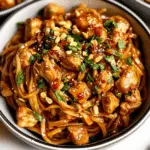Kung Pao Chicken Noodles combine tender chicken pieces, vibrant vegetables, and hearty noodles, all tossed in a spicy and savory sauce. This dish offers a delightful blend of flavors and textures, making it a perfect choice for a quick and satisfying meal.
Why You’ll Love This Recipe
- Quick and Easy: Ready in about 30 minutes, making it ideal for busy weeknights.
- Customizable: Easily adaptable with your preferred vegetables or protein alternatives.
- Flavorful: A harmonious balance of spicy, sweet, and savory notes that tantalize the taste buds.
- Gluten-Free Option: By using gluten-free noodles and tamari, this dish can accommodate gluten sensitivities.
Ingredients
- 12 ounces noodles of choice (e.g., brown rice udon, ramen, pad thai noodles, or spaghetti)
- 1 pound chicken breast, cut into 1-inch pieces
- 2 tablespoons low-sodium tamari or soy sauce
- 1 tablespoon honey
- 1 tablespoon chili paste
- 1 tablespoon toasted sesame oil
- ½ cup diced green onion (mostly the white part)
- 1 tablespoon minced garlic
Tip: You’ll find the full list of ingredients and measurements in the recipe card below.
For the Sauce:
- ½ cup low-sodium tamari or soy sauce
- 1 tablespoon peanut butter
- 2 tablespoons rice vinegar
- 2 tablespoons chili paste (e.g., sambal oelek)
- 1-2 tablespoons brown sugar (adjust to taste)
- ¼ teaspoon ground ginger
- 1½ tablespoons toasted sesame oil
- ½ teaspoon red pepper flakes (optional, for added spice)
- 3 tablespoons water
- 1 tablespoon cornstarch
For Garnish:
- ⅓ cup crushed peanuts
- ⅓ cup diced green onion (mostly the green part)
Directions
- Marinate the Chicken: In a bowl, combine the chicken pieces with 2 tablespoons of tamari or soy sauce, honey, and 1 tablespoon of chili paste. Mix well and set aside to marinate for at least 15 minutes.
- Cook the Noodles: Bring a pot of salted water to a boil and cook the noodles according to the package instructions. Drain and set aside.
- Prepare the Sauce: In a separate bowl, whisk together ½ cup of tamari or soy sauce, peanut butter, rice vinegar, 2 tablespoons of chili paste, brown sugar, ground ginger, 1½ tablespoons of toasted sesame oil, and red pepper flakes. In a small cup, mix the cornstarch with 3 tablespoons of water to form a slurry, then add it to the sauce mixture. Stir until well combined.
- Sauté Aromatics: Heat 1 tablespoon of toasted sesame oil in a large skillet or wok over medium-low heat. Add the diced green onion (white parts) and sauté for 2-3 minutes until fragrant. Add the minced garlic and cook for an additional minute.
- Cook the Chicken: Increase the heat to medium and add the marinated chicken to the skillet. Cook for 2-3 minutes on each side, or until the chicken is cooked through and reaches an internal temperature of 165°F (74°C).
- Combine with Sauce and Noodles: Pour the prepared sauce into the skillet with the chicken. Stir and let it simmer for a minute until it thickens slightly. Add the cooked noodles to the skillet and toss to combine, ensuring the noodles are evenly coated with the sauce.
- Serve: Transfer the Kung Pao chicken noodles to serving bowls. Garnish with crushed peanuts and the diced green onion (green parts). Serve immediately.
Servings and Timing
- Yield: 4 servings
- Prep Time: 10 minutes
- Cook Time: 20 minutes
- Total Time: 30 minutes
Variations
- Vegetable Additions: Enhance the dish by adding sautéed bell peppers, bok choy, kale, snap peas, broccoli, or other favorite vegetables. Sauté them in a bit of sesame oil before combining with the other ingredients.
- Protein Alternatives: Substitute the chicken with shrimp, tofu, or beef to suit your preference. For a vegan version, replace the chicken with tofu and the honey with maple syrup.
- Noodle Options: Use your preferred type of noodles, such as brown rice udon, ramen, pad thai noodles, or even regular spaghetti.
Storage/Reheating
- Storage: Allow the noodles to cool completely before transferring them to an airtight container. Store in the refrigerator for up to 3 days.
- Reheating: For best results, reheat the noodles on the stovetop with a touch of oil over medium heat until warmed through. While microwaving is an option, it may alter the texture of the chicken.
FAQs
What type of noodles work best for Kung Pao Chicken Noodles?
Brown rice udon noodles are a great choice, but you can also use ramen, pad thai noodles, or even regular spaghetti. Choose based on your preference and dietary needs.
Can I make this dish vegetarian or vegan?
Yes, to make a vegetarian or vegan version, substitute the chicken with tofu and replace the honey with maple syrup. Ensure that the other ingredients, such as soy
Print
Kung Pao Chicken Noodles
- Prep Time: 10 minutes
- Cook Time: 20 minutes
- Total Time: 30 minutes
- Yield: 4 servings
- Category: Main Course
- Method: Stir-Fry
- Cuisine: Asian Fusion
- Diet: Gluten Free
Description
Satisfy your craving for bold and spicy flavors with Kung Pao Chicken Noodles! This quick and easy stir-fry dish features tender chicken, vibrant noodles, and a savory-sweet sauce with a kick of heat. Perfect for weeknight dinners or a flavorful meal any time!
Ingredients
For the Noodles:
- 12 oz noodles (brown rice udon, ramen, pad thai noodles, or spaghetti)
- 1 lb chicken breast, cut into 1-inch pieces
- 2 tbsp low-sodium tamari or soy sauce
- 1 tbsp honey (or maple syrup for vegan)
- 1 tbsp chili paste (e.g., sambal oelek)
- 1 tbsp toasted sesame oil
- ½ cup diced green onion (white parts)
- 1 tbsp minced garlic
For the Sauce:
- ½ cup low-sodium tamari or soy sauce
- 1 tbsp peanut butter
- 2 tbsp rice vinegar
- 2 tbsp chili paste (e.g., sambal oelek)
- 1–2 tbsp brown sugar (to taste)
- ¼ tsp ground ginger
- 1½ tbsp toasted sesame oil
- ½ tsp red pepper flakes (optional)
- 3 tbsp water
- 1 tbsp cornstarch (slurry with water)
For Garnish:
- ⅓ cup crushed peanuts
- ⅓ cup diced green onion (green parts)
Instructions
- Marinate the Chicken:
In a bowl, mix chicken pieces with tamari or soy sauce, honey, and chili paste. Let marinate for at least 15 minutes. - Cook the Noodles:
Bring salted water to a boil and cook noodles according to package instructions. Drain and set aside. - Prepare the Sauce:
In a bowl, whisk together tamari, peanut butter, rice vinegar, chili paste, brown sugar, ground ginger, sesame oil, and red pepper flakes. Add the cornstarch slurry and mix until smooth. - Sauté Aromatics:
Heat 1 tbsp sesame oil in a large skillet or wok over medium-low heat. Add diced green onion (white parts) and sauté for 2–3 minutes. Add minced garlic and cook for another minute. - Cook the Chicken:
Turn heat to medium and add marinated chicken. Cook for 2–3 minutes on each side until cooked through and golden brown. - Combine Sauce and Noodles:
Pour the sauce into the skillet with the chicken. Stir and let it simmer until slightly thickened, about 1–2 minutes. Add cooked noodles and toss until evenly coated. - Serve:
Divide into bowls and garnish with crushed peanuts and diced green onion (green parts). Serve immediately.
Notes
- Make It Vegan: Substitute chicken with tofu and honey with maple syrup.
- Spicy Option: Add extra chili paste or red pepper flakes for more heat.
- Vegetable Additions: Include sautéed bell peppers, broccoli, or snap peas for extra flavor and nutrition.



Your email address will not be published. Required fields are marked *